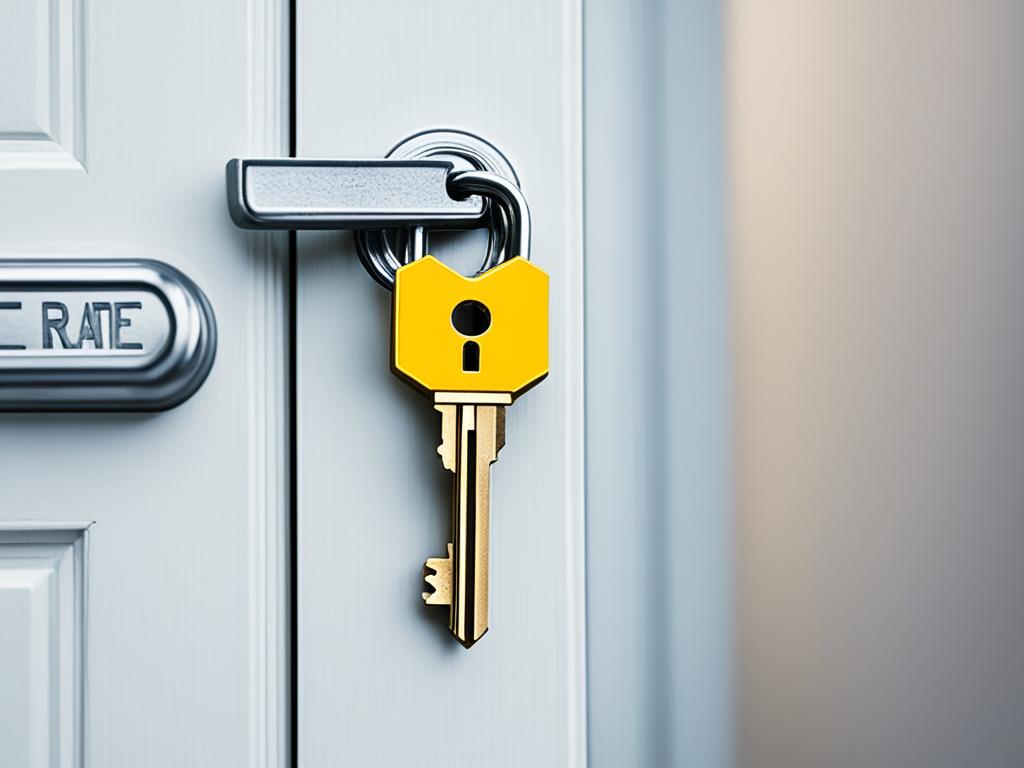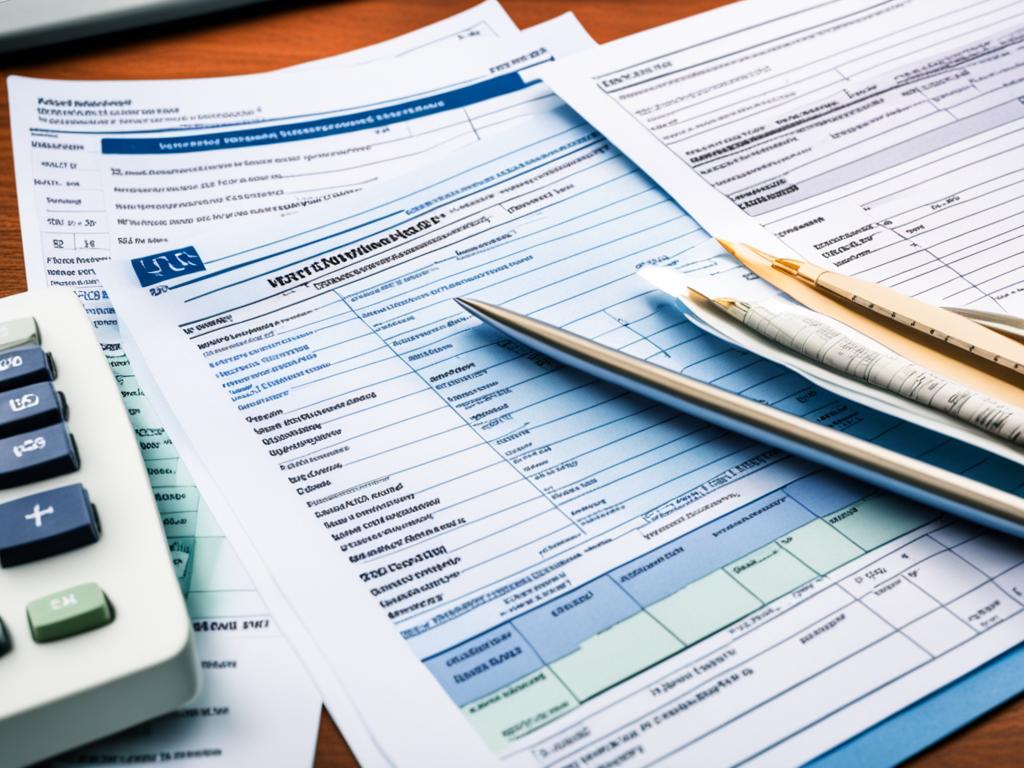Are you feeling overwhelmed by the thought of navigating the mortgage process? Don’t worry, you’re not alone. Many homebuyers find the mortgage journey to be complex and intimidating. But what if we told you that it doesn’t have to be?
By following five simple steps, you can navigate the mortgage process with ease, from getting pre-qualified to closing the deal. We’ll guide you through each stage of the mortgage journey and provide essential tips for homebuyers. Don’t let the fear of the unknown hold you back – master your home loan process today.
Key Takeaways:
- Five simple steps can help navigate the mortgage process with ease.
- Getting pre-qualified is an important first step in determining affordability.
- Locking in an interest rate can save you money in the long run.
- The loan approval process involves appraisal, underwriting, and escrow.
- Closing the deal is the final step in becoming a homeowner.
Step 1: Get Pre-Qualified
Before you start house hunting, it’s important to get pre-qualified for a mortgage. This will give you a clear understanding of what you can afford and help you narrow down your search.
Getting pre-qualified is a simple process that involves providing financial information such as your employment history and tax returns. By pre-qualifying, you’ll have an idea of your affordability, which can save you time and effort in your homebuying journey.
To make the pre-qualification process even easier, we offer a fast, simple, and secure digital mortgage application tool. You can conveniently fill out the application online, providing the necessary details without the hassle of paperwork or long wait times. Our mortgage experts will review your application and provide you with a pre-qualification letter that outlines your borrowing capacity.
By getting pre-qualified, you’ll have a competitive edge in the housing market, showing sellers and agents that you are a serious buyer. It will give you confidence in your budget and allow you to make informed decisions when choosing your dream home. Don’t skip this essential step – get pre-qualified today and take the first step towards homeownership!

Step 2: Submit Your Loan Application
Once you’ve found the home you want, it’s time to submit your loan application. This is a crucial step in the mortgage process, as it initiates the evaluation and approval of your loan. To ensure a smooth application process, follow these steps:
- Decide on a Loan Program: Before submitting your loan application, it’s important to choose the loan program that best fits your needs. Whether you’re considering a conventional loan, FHA loan, or VA loan, carefully evaluate the eligibility requirements, interest rates, and terms of each program.
- Collect Required Documentation: Gather all the necessary personal and financial documents to complete your loan application. These documents may include:
- Proof of income: Recent pay stubs, W-2 forms, or tax returns to verify your employment status and income.
- Bank statements: Provide up-to-date statements for your checking and savings accounts to demonstrate your financial stability.
- Identification: A valid driver’s license or passport to establish your identity.
- Credit history: Obtain a copy of your credit report to review your credit score and address any discrepancies.
Once your loan application is submitted, your lender will begin the process of evaluating your financial information and determining your eligibility for a mortgage. You will also receive a loan estimate that breaks down the costs and terms of your loan, providing you with a clear understanding of what to expect. Our team of experienced loan originators and mortgage experts are here to guide you through this process and help you select the best loan program for your specific needs.
Don’t hesitate to reach out to us if you have any questions or need assistance with your loan application. We’re here to make this step of the mortgage process as smooth and stress-free as possible.

Loan Comparison
| Loan Program | Interest Rate | Loan Term | Down Payment |
|---|---|---|---|
| Conventional Loan | 3.25% | 30 years | 20% |
| FHA Loan | 3.50% | 30 years | 3.5% |
| VA Loan | 3.00% | 30 years | 0% |
“Submitting your loan application is the gateway to homeownership. Take the time to gather all necessary documents and carefully review your loan program options. Our team is here to support you every step of the way.”
Step 3: Lock in an Interest Rate
Mortgage rates can fluctuate daily, which is why it’s crucial to lock in an interest rate at the right time. By doing so, you can secure a favorable rate for your mortgage. Your loan originator is there to guide you on when to lock in your rate, ensuring you get the best deal possible. Whether you choose to lock your rate at the time of your application or wait to see if rates drop, we’ll provide the information and expertise you need to make an informed decision.
You have the option to lock in your interest rate at the time of your mortgage application or take a rate float and lock it in later. When you lock in your rate, it means that the lender guarantees a specific interest rate for a certain period.
During the rate lock period, the agreed-upon rate will not change even if mortgage rates increase. This protects you from any rise in rates before your loan closes.
However, it’s important to note that once you lock in your rate, you are committed to that rate for the duration of the lock period, typically ranging from 30 to 60 days. If rates decrease during the lock period, you won’t be able to take advantage of the lower rates unless your lender offers a float-down option.
Rate Lock Options
When discussing rate lock options with your loan originator, you’ll have several choices to consider:
- Standard Rate Lock: This is the most common type of rate lock, where the interest rate is fixed for the entire lock period.
- Float-Down Rate Lock: Some lenders offer the option to float down to a lower rate if market conditions improve during the lock period.
- Rate Lock Extension: If your loan takes longer to close than expected, a rate lock extension allows you to maintain the agreed-upon rate for an extended period, typically for an additional fee.
When deciding on a rate lock option, consider factors such as how long it will take to close your loan, whether rates are expected to rise or fall, and your personal risk tolerance.
| Rate Lock Option | Features |
|---|---|
| Standard Rate Lock | Interest rate remains fixed for the entire lock period. |
| Float-Down Rate Lock | If rates improve during the lock period, you have the option to lower your rate. |
| Rate Lock Extension | Allows you to maintain the agreed-upon rate if your loan takes longer to close. |
By carefully considering your options and working closely with your loan originator, you can make an informed decision and lock in an interest rate that aligns with your financial goals and timeline.

Step 4: Get Your Loan Approved
After submitting your application and locking in your interest rate, there are three major steps to complete before your loan is approved:
- Appraisal: An appraisal will be conducted to determine the fair market value of the property. This is important for the lender to ensure they are financing a property that is worth the amount of the loan. The appraiser will assess the property’s condition, location, and comparable sales in the area to determine its value.
- Underwriting: The loan will go through underwriting, where the criteria and regulations of the sale will be reviewed. The underwriter will carefully evaluate your financial documents, credit history, and the property appraisal to ensure that you meet the lender’s requirements and that the loan is a suitable risk. They may request additional documentation or clarification during this process.
- Escrow: Escrow will be initiated, involving a third party who ensures all conditions of the sale are met. Escrow protects both the buyer and the seller during the transaction by holding funds and important documents until all requirements are fulfilled. The escrow officer will coordinate with the lender, buyer, seller, and other parties involved to ensure a smooth and secure closing process.
During this time, it’s crucial to avoid making any major financial moves or changes that could affect your mortgage approval. Stick to your original financial plan and be responsive to any requests or inquiries from the lender or underwriter.
Now, let’s move on to the final step of the mortgage process – closing the deal!
Step 5: Close the Deal
Congratulations! You’re nearing the finish line. The final step in the mortgage process is to close the deal and become a proud homeowner. This is an exciting milestone on your journey towards owning a home.
Prior to closing, you will receive a closing disclosure document. This disclosure provides a detailed breakdown of all the costs associated with the transaction, ensuring that there are no surprises on closing day. It’s important to carefully review this document and address any questions or concerns you may have.
On the much-anticipated closing day, you will meet with the seller, your real estate agent, and a representative from the title company or attorney’s office. During this meeting, you will sign all the final documents, including the mortgage agreement and the deed. This is the moment when the property officially becomes yours, and you become a homeowner.
While the closing process can vary depending on the location and other factors, it generally takes a few hours. The actual closing day is a significant event that marks the completion of your mortgage journey and the start of your new chapter as a homeowner.

Enjoy this special moment and embrace the joy and pride that comes with owning your own home. This is the result of your hard work and determination throughout the mortgage process.
“Closing day is the culmination of a journey and the beginning of a new chapter. Take a moment to savor the excitement and achievement.”
Costs to Expect on Closing Day
On closing day, you will need to bring funds to cover various costs associated with the transaction. These costs can include:
| Expense | Estimated Cost |
|---|---|
| Down payment | $XX,XXX |
| Closing costs | $XX,XXX |
| Appraisal fees | $X,XXX |
| Home inspection fees | $X,XXX |
| Property taxes | $X,XXX |
| Homeowners insurance | $X,XXX |
Please note that these costs are estimates and can vary based on factors like the purchase price of the property and local taxes. Your mortgage lender will provide you with a detailed breakdown of the costs you can expect on closing day.
Now that you’ve closed the deal, you can proudly call yourself a homeowner. Cherish this moment and enjoy the journey ahead in your new home.
Figure Out What You Can Afford
Before starting the home buying and mortgage process, it’s important to assess your finances and determine what you can afford. Understanding your budget will help you make informed decisions and avoid financial strain in the future. To figure out what you can afford, consider using a home affordability calculator. This powerful tool takes into account your income, monthly expenses, and other financial factors to determine a realistic price range for your home.
Using a home affordability calculator is easy. Simply input your financial information, such as your annual income, current debts, and desired down payment amount. The calculator will then generate an estimate of how much house you can afford based on your financial situation. It will also provide an estimate of your monthly mortgage payment, taking into consideration factors like interest rates and loan term.
By using a home affordability calculator, you’ll be able to set a realistic budget for your home search. This will save you time and effort by ensuring you focus on properties within your price range. Additionally, it will give you confidence when making offers and negotiating prices, knowing that you have a clear understanding of what you can comfortably afford.
| Benefits of Using a Home Affordability Calculator |
|---|
|

Using a home affordability calculator is a crucial step in the home buying process. It empowers you to make informed financial decisions and ensures that you stay within your means. Don’t skip this important step – start calculating your ideal budget today!
Get Preapproved For A Loan
Getting preapproved for a loan is a crucial step in the mortgage process. It shows sellers and real estate agents that you’re a serious buyer and gives you a clear understanding of your budget.
When you get preapproved, mortgage lenders calculate the preapproval amount based on factors such as your income, credit history, and assets. This not only helps you determine the interest rate you qualify for but also gives you a realistic budget to work with when searching for your dream home.
To get started, choose a lender who specializes in mortgage preapproval and offers competitive interest rates. Then, complete the loan application process, which typically involves providing information about your employment history, income, assets, and debts.
Once your application is submitted, the lender will review your financial information and evaluate your creditworthiness. They may also ask for additional documentation to verify your income and assets. It’s important to be prepared and provide all requested documentation promptly to speed up the preapproval process.
Keep in mind that mortgage preapproval is not a guarantee of a loan, but it significantly increases your chances of securing financing when you find the perfect home. With your preapproval letter in hand, you can confidently make offers and negotiate with sellers, knowing that you have the financial backing to follow through.
Now that you understand the importance of mortgage preapproval, it’s time to take the first step towards homeownership. Choose a reputable lender, gather all the necessary documentation, and apply for your preapproval today.

Find Your Dream Home And Put In An Offer
Now that you’ve been preapproved, it’s time to embark on the exciting journey of finding your dream home. To make the process easier and more streamlined, it’s highly recommended to seek the guidance of a professional real estate agent. A real estate agent can help you navigate the market, narrow down your options, and negotiate on your behalf. With their expertise and knowledge of the local market, they can assist you in finding the perfect property that meets your needs and preferences.
Once you’ve found the one, it’s time to make an offer! This is your opportunity to express your interest in purchasing the home. Making a competitive offer is crucial, especially in a competitive market. Your real estate agent can provide valuable insights and advice on crafting an offer that stands out. It’s important to consider factors such as the listing price, market conditions, and comparable sales in the area when determining your offer amount.
When submitting your offer, it’s common practice to include an earnest money deposit. An earnest money deposit is a sum of money that demonstrates your commitment and seriousness as a buyer. It signifies your intention to proceed with the purchase. The earnest money deposit is typically held in escrow until the sale is finalized.
Remember, the real estate agent will guide you through the process of making an offer and will ensure that all necessary paperwork is completed accurately and in a timely manner. With their support, you can confidently submit your offer and take the next steps towards homeownership.

Finalize Your Choice For Your Mortgage Lender
Once your offer is accepted on your dream home, it’s time to make a crucial decision – choosing the right mortgage lender. This step is crucial as it can significantly impact your financial journey. Take the time to shop around and compare different mortgage lenders to find the best fit for your needs.
When choosing a mortgage lender, there are two key factors to consider – interest rates and loan terms. Interest rates determine the amount of interest you’ll pay over the life of your loan, so finding a lender with competitive rates can save you thousands of dollars. Similarly, loan terms, such as the length of the loan and any adjustable rate features, can vary from lender to lender, so it’s essential to choose terms that align with your financial goals.
Take advantage of online tools and resources to research mortgage lenders and their offerings. Look for lenders with a strong reputation, positive customer reviews, and a track record of providing excellent service. Ask friends, family, and real estate agents for recommendations to find lenders who have successfully worked with borrowers in similar situations to yours.
Once you’ve narrowed down your options, reach out to each lender for more information. Ask questions about their interest rates, loan terms, and any additional fees or charges that may be involved. Understanding the fine print will help you make an informed decision.
Evaluating Mortgage Lenders
Here are a few key factors to consider when evaluating mortgage lenders:
- Interest rates: Compare the interest rates offered by different lenders to find the most competitive options. Even a small difference in interest rates can have a significant impact on your monthly mortgage payment and the total cost of your loan.
- Loan terms: Review the loan terms offered by each lender to determine which aligns with your goals. Consider factors such as the length of the loan, whether it’s a fixed or adjustable rate loan, and any associated fees or penalties.
- Customer service: Research each lender’s reputation for customer service. Look for lenders who are responsive, knowledgeable, and proactive in guiding you through the mortgage process.
Remember, the mortgage lender you choose will be your partner throughout the loan process, so it’s essential to select a lender who understands your unique needs and priorities. By finalizing your choice for a mortgage lender, you’ll be one step closer to securing the financing you need for your dream home.
Comparing Mortgage Lenders
| Lender | Interest Rates | Loan Terms | Customer Service Rating |
|---|---|---|---|
| ABC Mortgage Bank | 3.25% | 30-year fixed rate | 4.5/5 |
| XYZ Mortgage Company | 3.15% | 15-year fixed rate | 4/5 |
| DEF Home Loans | 3.35% | Adjustable rate, 5/1 ARM | 4.2/5 |
Table: Comparing mortgage lenders based on their interest rates, loan terms, and customer service ratings.

Submit Your Mortgage Application
Now that you’ve chosen a mortgage lender, it’s time to take the next step in the mortgage process: submitting your mortgage application. This is a crucial part of the journey, as it allows the lender to gather the necessary information to assess your eligibility for a mortgage loan.
To successfully complete the application, you will need to provide certain documents and information. These will typically include:
- Personal identification, such as your driver’s license or passport.
- Proof of income, such as pay stubs or tax returns.
- Bank statements to verify your assets and financial stability.
- Employment history and contact information for your employer(s).
- Information about any outstanding debts or financial obligations.
Make sure to review the lender’s specific requirements and gather all the necessary documents before starting the application process. This will help streamline the process and avoid any delays.
Once you’ve submitted your mortgage application, the lender will review the information provided and determine whether you qualify for a loan. This review process may involve verifying the accuracy of the documents submitted, assessing your creditworthiness, and evaluating your ability to repay the loan.
After reviewing your application, the lender will provide you with a loan estimate. This document outlines the terms, rates, and fees associated with the mortgage loan. Take the time to carefully review the loan estimate and ask any questions you may have. Understanding the terms of the loan is crucial to making an informed decision.
Submitting your mortgage application is a significant milestone in the mortgage process. It brings you one step closer to achieving your dream of homeownership. With the necessary documents in hand and an understanding of the loan estimate, you are well-prepared to move forward on your mortgage journey.

“The mortgage application is a crucial step in the process of obtaining a mortgage loan. Providing accurate and complete documentation is essential for a smooth and successful application process.”
Conclusion
Understanding the mortgage process is key to successfully navigating the homebuying journey, whether you’re a first-time buyer or looking to refinance. Each stage, from getting prequalified to closing the deal, plays a crucial role in achieving your homeownership goals. By working with a trusted lender and staying informed, you can simplify the mortgage process and make it more manageable.
Beginning with the important step of getting prequalified, you can determine your affordability and narrow down your search. Then, by submitting your loan application and locking in an interest rate, you can progress towards getting your loan approved. Finally, at the closing stage, all final documents will be signed, and you will officially become a homeowner.
Remember, the mortgage process can be complex, but by following these steps and seeking guidance from professionals, you can overcome any challenges. As a first-time buyer, it’s particularly important to stay informed and ask questions if you’re unsure about any aspect of the process. With determination and the right support, you can confidently navigate the mortgage process and achieve your dream of homeownership.
FAQ
What is the first step in the mortgage process?
The first step is to get pre-qualified for a mortgage. This will help you understand what you can afford and narrow down your search.
How can I get pre-qualified for a mortgage?
You can get pre-qualified by gathering financial information such as employment history and tax returns and using our fast and secure digital mortgage application tool.
What do I need to do after finding the home I want?
After finding your dream home, you need to submit your loan application, decide on a loan program, collect required personal documentation, and sign all related documents.
How do I lock in an interest rate?
Your loan originator can guide you on when to lock your rate. Whether you choose to lock it at the time of your application or wait for potential rate drops, we’ll provide the information you need to make an informed decision.
What are the major steps to complete before loan approval?
The major steps include a property appraisal to determine its value, underwriting to review the criteria and regulations, and escrow initiation to ensure all sale conditions are met.
What happens on closing day?
On closing day, you will receive a closing disclosure outlining all transaction costs and terms. You will then sign all final documents and officially become a homeowner.
How can I determine what I can afford?
Use a home affordability calculator to understand how much house you can afford and estimate your monthly mortgage payment. This will help you set a realistic budget.
Why is mortgage preapproval important?
Mortgage preapproval shows sellers and agents you’re a serious buyer and gives you a clear understanding of your budget. It can also help determine the interest rate you qualify for.
What is the role of a real estate agent in the home buying process?
A real estate agent can help you navigate the home buying journey, provide expertise, and assist in finding the perfect property.
How do I finalize my choice for a mortgage lender?
Shop around with different lenders to find the best interest rates and loan terms. Compare offers and ask questions to make an informed decision.
What should I do after choosing a mortgage lender?
Complete and submit your mortgage application, providing all necessary documents and information. Review the loan estimate and ask any necessary questions before proceeding.
What can help simplify the mortgage process?
By understanding the mortgage process, working with a trusted lender, and staying informed, you can simplify the overall homebuying journey.